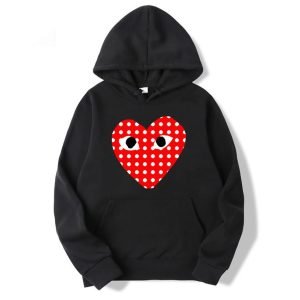Rei Kawakubo, the visionary behind Comme des Garçons, has long been celebrated for her refusal to conform to traditional fashion standards. Her disruptive approach — dismantling silhouettes, rejecting gender binaries, and reimagining beauty — has ignited a wave of inspiration beyond Japan. Among her most passionate disciples are German Comme Des Garcons designers, who increasingly embrace rebellion as a foundational design language. Across Berlin, Hamburg, and Düsseldorf, a new generation of creatives merge Kawakubo’s radical philosophy with German precision, forging an identity that is intellectually bold yet culturally grounded.
The German Fascination with Anti-Perfectionism
Germany is historically known for discipline, structure, and order. Yet within its fashion landscape, there is a growing hunger to resist that very rigidity. Kawakubo’s anti-perfectionist ethos — garments that appear unfinished, asymmetrical, or intentionally deconstructed — offers German creators a chance to break free from societal expectations without abandoning technical craftsmanship. Designers like William Fan, GmbH, and Kasia Kucharska reinterpret Kawakubo’s spirit through sleek tailoring, recycled textiles, and gender-fluid cuts, proving that rebellion can be engineered rather than improvised.
This contrast between rigorous construction and deliberate chaos defines modern German avant-garde fashion. While Paris celebrates glamour and Milan thrives on opulence, Berlin champions defiance, and Rei Kawakubo’s aesthetic is its guiding anthem.
Berlin: The Capital of Controlled Anarchy
No other European city mirrors Kawakubo’s philosophy of creative contradiction as closely as Berlin. Industrial, gritty, and unapologetically raw, Berlin offers fertile ground for nonconformist fashion. Alternative fashion schools like Universität der Künste and Weißensee Academy encourage experimental design, drawing students deeper into Kawakubo’s concept of “anti-fashion.”
German designers inspired by Rei incorporate:
-
Monochrome layering echoing Comme des Garçons’ early black period
-
Voluminous silhouettes designed not to flatter but to provoke
-
Recycled industrial fabrics that challenge luxury status norms
Rather than seeking commercial approval, these designers pursue cultural impact. Just as Kawakubo rejected Western standards of femininity and elegance, Berlin-based creators reject consumer-driven aesthetics, pushing fashion back toward philosophical expression.
Minimalism Meets Chaos: A Distinct German Interpretation
While Rei Kawakubo often embraces maximalist chaos, German rebellion is more restrained. It is not loud for spectacle’s sake — it is silent opposition. Where Japanese avant-garde revels in asymmetry and abstraction, German designers infuse rebellion with mathematical precision.
We see this in the work of Stephan Schneider and Haderlump Atelier Berlin, where garments appear simple at a glance but reveal hidden structure, detachable layers, or unexpected openings. The rebellion lies not in visual noise but in functional subversion. A coat can morph into a backpack. A dress can be worn backward. Kawakubo’s legacy lives on not as imitation but as evolution.
Genderless Fashion as Cultural Protest
Rei Kawakubo has always resisted traditional gender markers in clothing. Her garments exist beyond man or woman, prioritizing expression over identity labels. German designers have adopted this ideology eagerly — but not just as a trend. In a society still grappling with conservative norms in smaller cities, genderless fashion becomes a political statement.
Labels like GmbH, Namilia, and Richert Beil have made androgyny central to their identity, using clothes to dismantle patriarchy rather than simply sell garments. Their collections reflect Kawakubo’s belief that clothing can be a tool for liberation rather than mere decoration.
Sustainability Through Rebellion
Kawakubo’s rebellion was never about wasteful excess. In fact, her philosophy aligns seamlessly with Germany’s commitment to sustainability. Many German designers influenced by her work incorporate deadstock materials, modular garments, and anti-consumerist practices. Their message is not just “buy differently” — it’s “own less, express more.”
Rebellion is no longer expressed through loud slogans but through quiet refusal of fast fashion culture. Kawakubo’s defiance of seasonal cycles mirrors Germany’s growing movement toward timeless wardrobes.
Runway as Performance, Not Commerce
One of Rei’s most iconic contributions to fashion is her ability to turn runways into theatre. Her shows are not product showcases — they are philosophical installations. German designers are now embracing this performative style. Instead of standard catwalks, many present collections through immersive presentations in abandoned factories, warehouses, and techno clubs. Lights flicker, industrial music blares, and garments move like living sculptures.
One of the most profound impacts of Comme des Garçons in conservative German contexts lies in its gender-blurring silhouettes. Where traditional culture expects clear masculine and feminine dress codes, Rei Kawakubo’s designs dissolve them entirely.
For many wearers, this offers psychological liberation. A man in Düsseldorf wearing a ruffled tunic jacket is not making a flamboyant statement — he is expressing comfort with softness without sacrificing strength. A woman in Mannheim wearing a boxy, austere coat is reclaiming power without glamor.
These choices challenge centuries of visual conditioning without requiring direct protest. They ask society to expand definition rather than choose sides.
Conclusion: Wearing Comme des Ga
One of the most profound impacts of Comme des Garçons in conservative German contexts lies in its gender-blurring silhouettes. Where traditional culture expects clear masculine and feminine dress codes, Rei Kawakubo’s designs dissolve them entirely.
For many wearers, this offers psychological liberation. A man in Düsseldorf wearing a ruffled tunic jacket is not making a flamboyant statement — he is expressing comfort with softness without sacrificing strength. A woman in Mannheim wearing a boxy, austere coat is reclaiming power without glamor.
These choices challenge centuries of visual conditioning without requiring direct protest. They ask society to expand definition rather than choose sides.
Conclusion: Wearing Comme des Garçons Is a Psychological Language
To outsiders, Comme des Garçons may seem chaotic. But in reality, it is highly strategic self-expression, especially in conservative German cities. Each pleat, ruffle, and irregular cut becomes a sentence in a language of defiance, spoken softly but persistently.
It is rebellion without aggression, luxury without ego, individuality without isolation.
In the stillness of Germany’s most restrained cities, Comme des Garçons speaks louder than words — not through volume, but through unquestionable conviction.
rçons Is a Psychological Language
To outsiders, Comme des Garçons may seem chaotic. But in reality, it is highly strategic self-expression, especially in conservative German cities. Each pleat, ruffle, and irregular cut becomes a sentence in a language of defiance, spoken softly but persistently.
It is rebellion without aggression, luxury without ego, individuality without isolation.
In the stillness of Germany’s most restrained cities, Comme des Garçons speaks louder than words — not through volume, but through unquestionable conviction.
This transformation of fashion into experiential art is the clearest sign of Kawakubo’s legacy in Germany. Clothing is no longer passive — it commands dialogue.
The Future of German Avant-Garde Belongs to the Rebels
As the world increasingly drifts toward CDG Hoodie uniformity — algorithm-driven trends, mass-produced aesthetics, and influencer-approved minimalism — German designers stand firm in resistance. Their rebellion is not reckless; it is calculated, philosophical, and deeply rooted in cultural introspection.
Rei Kawakubo once said: “The only constant in fashion is change.” German designers have taken this to heart — not by chasing trends, but by burning down the very framework that defines them.
In the years to come, Germany is set to become Europe’s spiritual capital of conceptual fashion, not through imitation, but through intellectual rebellion — the purest tribute to Kawakubo’s legacy.




Leave a Reply